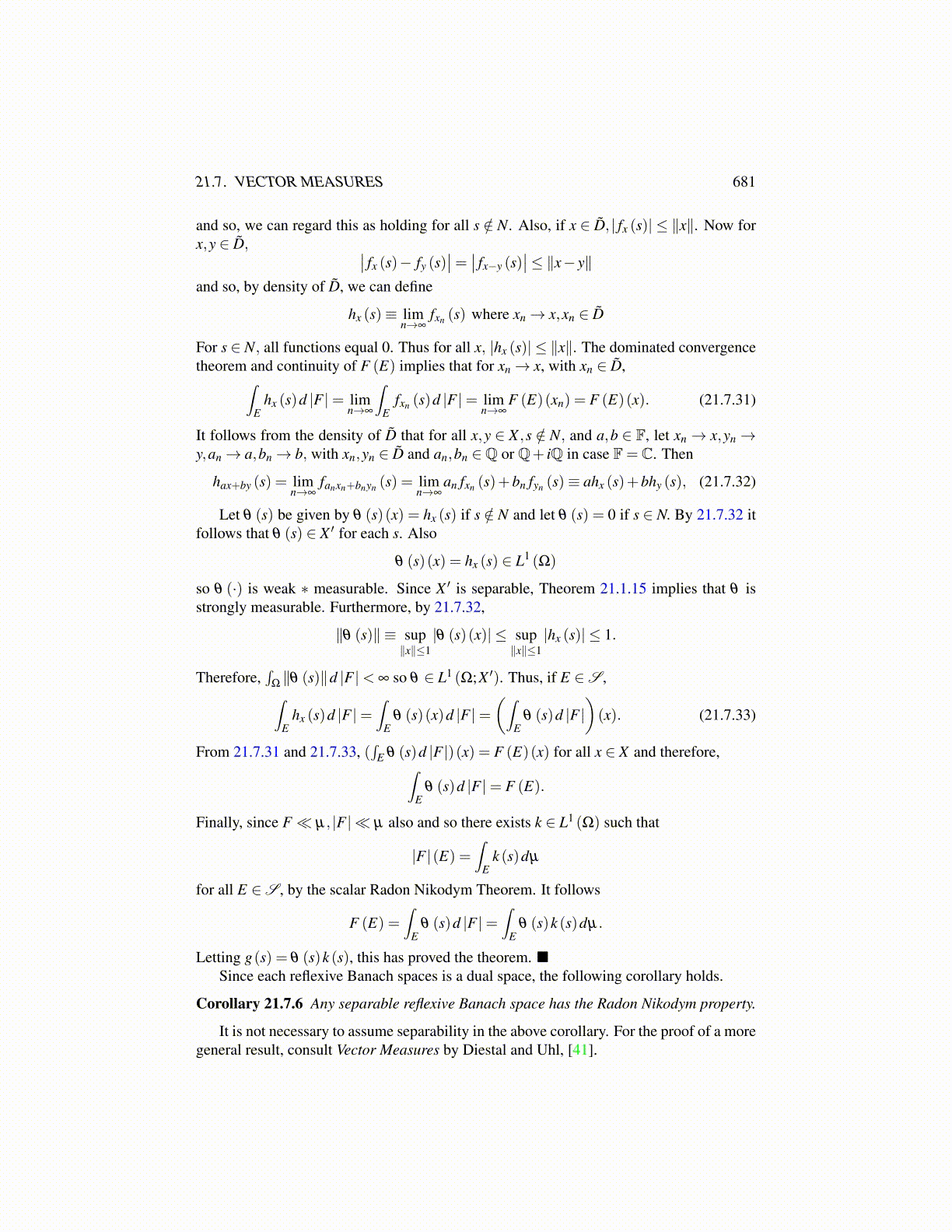
21.7. VECTOR MEASURES 681
and so, we can regard this as holding for all s /∈ N. Also, if x ∈ D̃, | fx (s)| ≤ ∥x∥. Now forx,y ∈ D̃, ∣∣ fx (s)− fy (s)
∣∣= ∣∣ fx−y (s)∣∣≤ ∥x− y∥
and so, by density of D̃, we can define
hx (s)≡ limn→∞
fxn (s) where xn→ x,xn ∈ D̃
For s ∈ N, all functions equal 0. Thus for all x, |hx (s)| ≤ ∥x∥. The dominated convergencetheorem and continuity of F (E) implies that for xn→ x, with xn ∈ D̃,∫
Ehx (s)d |F |= lim
n→∞
∫E
fxn (s)d |F |= limn→∞
F (E)(xn) = F (E)(x). (21.7.31)
It follows from the density of D̃ that for all x,y ∈ X ,s /∈ N, and a,b ∈ F, let xn→ x,yn→y,an→ a,bn→ b, with xn,yn ∈ D̃ and an,bn ∈Q or Q+ iQ in case F= C. Then
hax+by (s) = limn→∞
fanxn+bnyn (s) = limn→∞
an fxn (s)+bn fyn (s)≡ ahx (s)+bhy (s), (21.7.32)
Let θ (s) be given by θ (s)(x) = hx (s) if s /∈ N and let θ (s) = 0 if s ∈ N. By 21.7.32 itfollows that θ (s) ∈ X ′ for each s. Also
θ (s)(x) = hx (s) ∈ L1 (Ω)
so θ (·) is weak ∗ measurable. Since X ′ is separable, Theorem 21.1.15 implies that θ isstrongly measurable. Furthermore, by 21.7.32,
∥θ (s)∥ ≡ sup∥x∥≤1
|θ (s)(x)| ≤ sup∥x∥≤1
|hx (s)| ≤ 1.
Therefore,∫
Ω∥θ (s)∥d |F |< ∞ so θ ∈ L1 (Ω;X ′). Thus, if E ∈S ,∫E
hx (s)d |F |=∫
Eθ (s)(x)d |F |=
(∫E
θ (s)d |F |)(x). (21.7.33)
From 21.7.31 and 21.7.33, (∫
E θ (s)d |F |)(x) = F (E)(x) for all x ∈ X and therefore,∫E
θ (s)d |F |= F (E).
Finally, since F ≪ µ, |F | ≪ µ also and so there exists k ∈ L1 (Ω) such that
|F |(E) =∫
Ek (s)dµ
for all E ∈S , by the scalar Radon Nikodym Theorem. It follows
F (E) =∫
Eθ (s)d |F |=
∫E
θ (s)k (s)dµ.
Letting g(s) = θ (s)k (s), this has proved the theorem.Since each reflexive Banach spaces is a dual space, the following corollary holds.
Corollary 21.7.6 Any separable reflexive Banach space has the Radon Nikodym property.
It is not necessary to assume separability in the above corollary. For the proof of a moregeneral result, consult Vector Measures by Diestal and Uhl, [41].